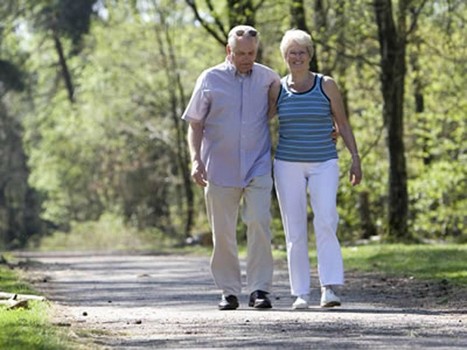Strong evidence has demonstrated physically active older adults have lower rates of diseases including heart disease and diabetes. They also have a lower risk of falls. Now it appears being active provides seniors with protection against brain damage on motor function.
Many older people have small areas of damage in their brains seen on magnetic resonance imaging (MRI) as white matter hyperintensities. Higher levels of this damage have been linked to more problems with movement, such as difficulty walking.
In a new study, researchers set out to test the hypothesis that physical activity modifies the association between white matter hyperintensity (WMH) burden and motor function in healthy older persons without dementia.
This new study involved 167 community-dwelling adults without dementia who were participants in the Rush Memory and Aging Project, mean age of 80 years and 30 percent of participants were males.
Total daily activity (exercise and non-exercise physical activity) was measured for up to 11 days with actigraphy. Eleven motor performances including both upper- and lower-extremity motor performance were summarized into a previously described global motor score. MRI scans were utilized to assess the volume of white matter hyperintensities in their brains.
After adjusting for age, sex, and education, total daily activity was not associated with white matter hyperintensities.
Researchers compared participants in different percentiles of total daily activity and found those with the highest activity levels (90th percentile) did not affect white matter hyperintensities burden in motor function. Participants in the 50th percentile activity level, having greater amounts of brain damage was associated with significantly lower scores on the movement tests and those in the top 10 percent, had greater amounts of brain damage did not change their scores on the movement tests.
The difference between the 90th and 50th percentiles is about an additional hour and a half of walking per day at 2.5 miles per hour, Dr Fleischman noted. And the difference between the 50th and 10th percentiles translates to just under an hour of additional walking per day.
For all the participants, the average score on the movement tests was 1.04. For people at the 50th percent activity level, scores ranged from 1.16 for those with the lowest amount of brain damage to 0.9 for those with the highest amount of brain damage. The detrimental effect was even stronger for those with the lowest levels of physical activity.
The results remained the same after researchers adjusted for other factors that could affect the relationship, such as body mass index (BMI), depression and vascular disease.
Dr. Debra Fleischman, PhD, i professor in the Departments of Neurological Sciences and Behavioral Sciences at Rush University Medical Center in Chicago, senior neuropsychologist at the Rush Alzheimer’s Disease Center and the study’s author commented “These results underscore the importance of efforts to encourage a more active lifestyle in older people to prevent movement problems, which is a major public health challenge.” “Physical activity may create a ‘reserve’ that protects motor abilities against the effects of age-related brain damage.”
Dr. Fleischman noted that the study does not determine whether physical activity causes people to preserve their movement abilities; it only shows the association.








